
In the first book, everything took time, patience, and a lot of watching and studying. And the second, the progression with the wolves. A romance is almost never necessary, and in this case, I found it especially egregious. While I do enjoy this second part of the trilogy for its peek into Eskimo life and how differently they see things from us gussaks, not to mention the kind of adorable visit with the wolves, there are two things that bug me. Still, it's a more satisfying conclusion to Miyax's story than the first book. Normally, that's not a complaint I would make, but so much time is spent in this tug-of-war between Miyax and Kapugen with neither of them giving any ground whatsoever that it gets tedious - and simultaneously makes the ending feel rushed, because the development isn't there to support it. This has a far more uplifting ending than the first one, but the issues I mentioned in my first review still bother me (aside from my personal inability to visualize objects being put together as described in books I'm better with that now, hooray) and now I have new troubles. It wasn’t necessary and didn’t add to the story.Ģ) how the Caribou returned and prevented Julie from wrapping up her conversation with her fatherģ) the white privileged wife changes the Inuit husband’s way of lifeĤ) the lack of emotion/grief related to Amaroq It was refreshing to have the dynamic reversed for a change.ġ) the addition of a love interest with Peter. She approached it from a place of recent experience and had the respect to give them time to see her point of view. The most interesting part was when Julie found the inner strength to stand up to her dad and his different views of the role of nature.

I liked how we had a behind the scenes view of Julie’s struggle about wanting an education but not at the risk of losing her wolf pack. Furthermore, it can’t have been easy to see all the changes since he’s been gone he flies planes, has traded his dogsled for a snowmobile, and abandoned his hunting for raising musk oxen for the village. It can’t have been easy for Julie to return to her father and his new wife. I loved how Craighead George explored change. Her quest in this book is to get her father to realize that the Eskimo (Inuit) and the villagers can co-exist. Her dad has been raising musk oxen and wolves are a major threat to his livelihood, so he sees them through a different lens than Miyax. She has learned to love her stepmom and forgive her dad, although she doesn’t fully understand what drove her dad to kill Amaroq, one of her beloved wolves. Miyax is now 15 and living with her father and his white wife in Kangik village.


We are cruising along the Inside Passage on our way to Alaska and I’ve just finished the 1994 sequel to the 1973 Julie of the Wolves, simply titled ‘Julie.’


 0 kommentar(er)
0 kommentar(er)
